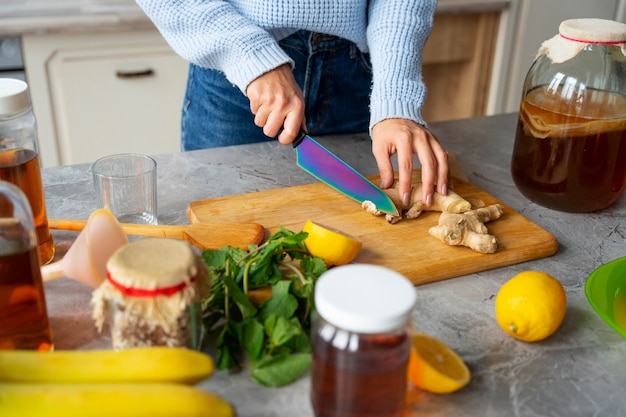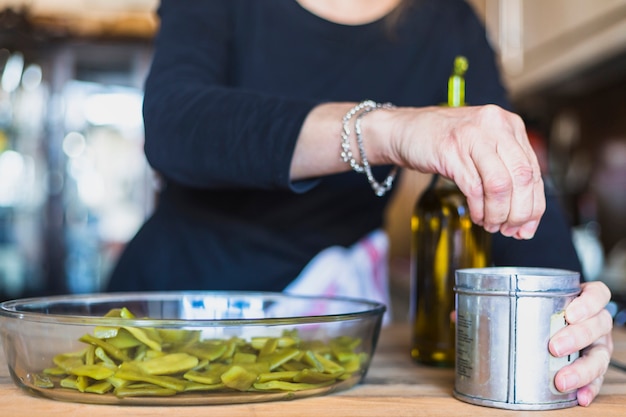I'll admit it, I'm a sucker for a good food trend. When I first heard about MCT oil and all its supposed benefits, I was hooked. The promise of increased energy, a little help with weight loss, and even improved brain function? Sign me up! But as a home cook who loves experimenting in the kitchen, one question kept popping up: can you actually cook with MCT oil?
I knew it was different from the usual cooking oils, but was it safe to use in high heat? Would it ruin my dishes? I dove into the research, tested out some recipes, and let me tell you, I learned a lot. Now I'm excited to share all the ins and outs of cooking with MCT oil, from the science behind it to delicious recipe ideas and even some potential risks to keep in mind.
(Part 1) What Exactly is MCT Oil?

First things first, let's break down what exactly MCT oil is. It stands for Medium-Chain Triglyceride oil. It's essentially a type of fat, but a very special one, extracted from either coconut oil or palm oil. The reason it's unique? Its chemical structure.
The Lowdown on Triglycerides
Most fats we consume are made up of long-chain triglycerides (LCTs). These take longer for our bodies to break down and absorb. But MCTs are different. They have much shorter carbon chains. This makes them super efficient - your body can digest and absorb them quickly, and they don't have to go through the usual digestive process. Instead, they go straight to your liver where they're turned into energy.
Different Types of MCTs
MCT oil is usually a blend of different MCTs, each with its own distinct properties. Here's a quick rundown:
- C6 (Caproic Acid): This is the shortest MCT, a real speed demon when it comes to absorption. It's like a quick shot of energy.
- C8 (Caprylic Acid): This is the star of the show in coconut oil. It's often linked to benefits for brain health and gut health, and researchers are still exploring its full potential.
- C10 (Capric Acid): This MCT is found in both coconut and palm oil. It's been suggested that it might support healthy blood sugar levels.
- C12 (Lauric Acid): While technically not a true MCT, it's often included in blends and is abundant in coconut oil. It's got a reputation for its antimicrobial properties.
(Part 2) The Benefits of Using MCT Oil

So, what makes MCT oil so popular? It's not just a fad, there are some genuine benefits to using it, both in your diet and in the kitchen.
1. Give Your Energy a Boost:
Remember those ketones I mentioned? MCTs are quickly converted into ketones, a fantastic alternative fuel source for your brain. This can give you a noticeable energy boost, particularly if you're following a ketogenic diet or intermittent fasting. I've noticed that a tablespoon in my morning coffee helps me feel sharper throughout the day, and I'm not the only one who swears by it.
2. Weight Loss Support:
MCT oil can potentially give your metabolism a little nudge and help you feel fuller for longer. Several studies have explored its role in weight loss, but it's crucial to remember that it's not a miracle cure. A balanced diet and regular exercise are still the cornerstones of healthy weight management.
3. Brain Power:
Studies are ongoing, but C8 (caprylic acid) in particular has shown promise in improving cognitive function and memory. This has sparked interest in its potential to help protect the brain from age-related decline.
4. Gut Health:
MCTs are considered prebiotics, which means they nourish the good bacteria in your gut. A healthy gut microbiome is like the foundation of overall health, impacting everything from digestion to immunity.
5. Fighting Inflammation:
Research suggests that MCT oil may have anti-inflammatory properties. This could be beneficial for managing conditions like arthritis and even heart disease, although more research is needed in this area.
(Part 3) Cooking With MCT Oil: The Do's and Don'ts

Now, let's get to the heart of the matter: can you cook with MCT oil? The answer is yes, but with a few important caveats. It's all about knowing its limitations and using it wisely.
The Smoking Point: A Key Factor
One of the most crucial things to consider is the smoking point. This is the temperature at which an oil starts to break down, releasing harmful compounds that can affect the flavor of your food and even be detrimental to your health. MCT oil has a relatively low smoking point, around 175°C (347°F), which is lower than oils like olive oil or avocado oil.
When MCT Oil Works
For gentle cooking methods like sautéing or stir-frying, MCT oil can be a wonderful choice. It imparts a subtle, slightly nutty flavor and delivers those benefits we discussed. You can even use it for baking, but it's best to avoid high-heat applications like deep-frying.
When to Switch to Other Oils
For those high-heat cooking situations, it's wise to use an oil with a higher smoking point, like avocado oil or coconut oil. You can even combine oils. Use a small amount of MCT oil for its flavor and benefits and a larger amount of a high-heat oil for the cooking process.
(Part 4) Delicious Recipes with MCT Oil
Ready to get cooking? Here are a few of my favorite recipes that incorporate MCT oil and its unique flavor. Feel free to get creative and experiment with different combinations!
1. Keto-Friendly MCT Oil Coffee
This is my morning ritual for a quick energy boost. It's so simple, and the taste is surprisingly good.
- Brew a strong cup of coffee (the stronger, the better!).
- Add 1-2 tablespoons of MCT oil to the coffee.
- Use a milk frother or whisk to blend it all together until the oil is fully incorporated.
- Enjoy!
2. Sauteed Vegetables with MCT Oil
A simple, healthy side dish that's perfect for any meal.
- Heat 1-2 tablespoons of MCT oil in a pan over medium heat.
- Add your favorite vegetables - broccoli, carrots, bell peppers, zucchini - you name it!
- Sauté until tender-crisp, about 5-7 minutes.
- Season with salt and pepper to taste.
- Serve hot and enjoy!
3. MCT Oil Pancakes
Fluffy pancakes that are delicious for breakfast even if you're following a ketogenic diet.
- In a bowl, whisk together 2 eggs, 1/4 cup almond flour, 1 tablespoon MCT oil, 1/2 teaspoon baking powder, and a pinch of salt.
- Heat a lightly oiled pan over medium heat.
- Pour 1/4 cup of batter onto the hot pan for each pancake.
- Cook for 2-3 minutes per side, or until golden brown.
- Serve with your favorite toppings: berries, nuts, whipped cream - go wild!
(Part 5) Important Things to Know About Potential Risks and Side Effects
Okay, MCT oil sounds great, but it's not all sunshine and rainbows. There are some potential downsides to be aware of.
1. Digestive Discomfort
One of the most common side effects, especially when taking large amounts, is digestive upset. This can include diarrhea, gas, and bloating. If you're new to MCT oil, start with a small amount and gradually increase your intake to see how your body reacts.
2. Liver Concerns
In rare cases, consuming excessive amounts of MCT oil can put a strain on the liver. This is more likely to happen in individuals with existing liver problems. If you have any liver conditions, talk to your doctor before incorporating MCT oil into your diet.
3. The Keto Flu
If you're following a ketogenic diet and suddenly increase your MCT oil intake, you might experience symptoms like headache, fatigue, and nausea. This is commonly called the "keto flu" and is usually temporary. The key is to increase your intake gradually to give your body time to adjust.
(Part 6) Choosing the Right MCT Oil
Not all MCT oils are created equal. When selecting one for your kitchen, there are a few factors to keep in mind.
1. The Source
MCT oil is typically derived from coconut oil or palm oil. It's always a good idea to opt for brands that use sustainably sourced ingredients.
2. Purity
Look for MCT oil that is pure and free from additives or fillers. Some brands may add flavors or other ingredients, so check the label carefully.
3. C8 Content
If you're primarily interested in the cognitive benefits, look for an oil with a high C8 (caprylic acid) content.
4. Taste
MCT oil has a slightly sweet and nutty taste. Some people find it pleasant, while others prefer flavorless options.
5. Price
High-quality MCT oil can be a bit pricier, but it's worth investing in a brand you trust.
(Part 7) Frequently Asked Questions
Here are some of the most common questions I get about MCT oil:
1. How much MCT oil should I take daily?
It's best to start slow and see how your body reacts. A good starting point is 1-2 tablespoons per day. You can gradually increase your intake if you find it's well-tolerated.
2. When is the best time to take MCT oil?
There's no one-size-fits-all answer. Some people find it helpful to take it in the morning for a boost of energy, while others prefer to take it before a workout or even before bed. Experiment to find what works best for you.
3. Can I cook with MCT oil every day?
It's generally safe to cook with MCT oil regularly, but it's wise to maintain a balanced intake. You can rotate it with other healthy cooking oils to ensure a diverse diet.
4. Is MCT oil safe for pregnant women?
There's limited research on the safety of MCT oil during pregnancy. It's always a good idea to talk to your doctor before taking any supplements, including MCT oil, during pregnancy or breastfeeding.
5. Can I give MCT oil to my child?
It's generally not recommended to give MCT oil to young children without consulting your doctor. Their digestive systems may not be fully equipped to handle it properly.
(Part 8) My Final Thoughts
So, is MCT oil worth the hype? I'd say yes. It offers some genuine benefits, both for your health and in the kitchen. Just remember, it's not a magical cure-all. A healthy lifestyle, including a balanced diet and regular exercise, is essential. But adding MCT oil to your routine can definitely be a valuable tool.
Have you tried cooking with MCT oil? What are your favorite recipes? Share your experiences in the comments below!
Everyone is watching

How to Cook Frozen Lobster Tails Perfectly: A Step-by-Step Guide
RecipesLobster. Just the word conjures up images of lavish meals, special occasions, and a taste of luxury. But let's...

Pigs in a Blanket Cooking Time: How Long to Bake for Perfect Results
RecipesAh, pigs in a blanket. Just the name conjures up images of those delightful little parcels of crispy pastry en...

Pork Fillet Cooking Time: How Long to Cook It Perfectly
RecipesPork fillet, or tenderloin as it's sometimes called, is a real favourite in our house. It's so versatile, and...

The Ultimate Guide to Tender, Juicy Pulled Pork
RecipesRight, let's talk pulled pork. It's one of those dishes that just screams "comfort food," doesn't it? I mean...

The Ultimate Guide to Cooking Delicious Frankfurters
RecipesLet's face it, we all love a good frankfurter. It's a classic, simple, and always satisfying. But let's be rea...
